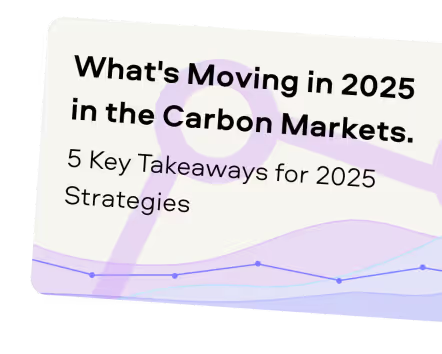「私たちは長年にわたり、信頼できる格付けの提供に注力し、現地データチームへの投資を重ねてきました。これにより当社の格付けの正確性は確保されていますが、購入者が検討している数千のプロジェクトにわたるスケールを実現することはできません。」
カーボンクレジット調達の最新動向について詳しくは、当社の記事「Key Takeaways for 2025」をご覧ください。調達戦略を改善するための、データに基づく5つのヒントをご紹介しています。

加えて:Connect to Supplyをご利用のお客様は、Sylveraのその他のツールもご利用いただけます。プロジェクトの格付け確認や強みの評価、高品質なカーボンクレジットの調達に加え、プロジェクトの進捗状況のモニタリング(特に発行前段階で投資している場合)も可能です。
Sylveraの無料デモを予約して、調達機能やレポーティング機能を体験しましょう。
カーボン・オフセットについて迷っているのは、あなただけではありません。オフセットに関する誤った情報や強い意見があふれており、オフセットがネット・ゼロ気候目標を達成し、気候変動の緩和を促進するためにできる最善の(あるいは最悪の)行動なのかどうかを知るのは難しいかもしれません。
Sylvera 、オフセットの仕組みと、地球を救うためにオフセットを最も効果的に利用する方法を理解するお手伝いをします。
カーボン・オフセットの究極のガイドブックです。
カーボン・オフセットとは何ですか?
カーボンクレジット ・オフセットは、必ずしもカーボン・オフセットではありません。カーボン・カーボンクレジット カーボン・オフセットになるのは、カーボン・オフセットに使用される場合、つまり企業や個人の温室効果ガス排出量(GHG)を補償するために償却される場合のみです。しかし、カーボン・クレジットにはカーボン・オフセット以外の用途もあります。
カーボン・オフセットを理解するには、まず カーボンフットプリントを理解する必要があります。
Zoomでのミーティング、チームへの昼食のおごり、業界イベントへの出張など、あなたの行動すべてが大気中に二酸化炭素を放出しています。カーボン・フットプリントは、あなたのライフスタイル(企業で言えば、あなたの事業活動)が大気中に排出する二酸化炭素の量で測定されます。
カーボンオフセットは、カーボンフットプリントの逆の役割を果たします。これらのプロジェクトは、温室効果ガスの排出を大気から除去するか、将来的に大気中に炭素が流入するのを回避するのに役立ちます。個人、企業、政府は、カーボン・クレジットを購入することで、直接またはサプライチェーンからの排出の影響を補償することができます。基本的に、排出された炭素1トンに対して、 除去または回避された同等の炭素1トンを購入し、自らの排出量を相殺することができます。
クレジットとオフセット
カーボン・クレジットと カーボン・オフセットという 言葉は、しばしば同じ意味で使われますが、まったく同じものではありません。
A カーボンクレジットは、地球の大気から回避または除去される二酸化炭素(CO2)1トン分に相当します。これがカーボン・オフセットの「カーボン」の由来です。カーボン・オフセットの「カーボン」は、温室効果ガス(GHG)の二酸化炭素換算量(CO2e)を表すこともできます。
カーボンクレジット ・オフセットは、必ずしもカーボン・オフセットではありません。 カーボンクレジット カーボン・オフセットになるのは、カーボン・オフセットに使用される場合、つまり企業や個人の温室効果ガス排出量(GHG)を補償するために償却される場合のみです。しかし、カーボン・クレジットにはカーボン・オフセット以外の用途もあります。
炭素クレジットは、 プロジェクト開発者によって販売される取引可能な単位です。地球大気中の炭素排出を回避、除去、削減するために作られます。排出される炭素は、化石燃料の燃焼や樹木の伐採など、さまざまな要因によって発生します。カーボンクレジット 、大気から回避または除去される二酸化炭素(CO2)または同等の温室効果ガスの1メートルトンを表します。
カーボン・オフセットの仕組み
カーボンニュートラルを達成しようとする場合、カーボンオフセットのプロセスは次のようになります:
- カーボンフットプリントの算出 組織、製品、サービスなどの温室効果ガス排出量を測定 (通常は暦年)。理想的には、事業やバリューチェーン(スコープ1、2、 3)全体から排出されるすべての排出量がここで考慮 されることになりますが、必ずしもそうとは限りません。
- クレジットは購入します: CO2排出量1トンにつき1枚のカーボンクレジット購入します。これらのカーボン・クレジットは、植林プロジェクトのように温室効果ガスを大気中から除去する炭素除去プロジェクトや、再生可能エネルギーへの取り組みのように温室効果ガスがそもそも大気中に到達しないようにする炭素回避プロジェクトによって生み出されます。
- クレジットの償却 その後、組織はレジストリでクレジットを「償却」または「取消」します。つまり、クレジットは再び取引されたり、他の誰にも請求されたりすることはなく、クレジットを償却した組織は、そのクレジットに関連するメートルトンのCeを単独で永久に所有することになります。そのため、クレジットを返還する組織は、そのクレジットに関連するCeのメートル・トンを単独で永続的に所有することになります。
ネット・ゼロを達成しようとする場合、オフセットのプロセスは次のようになります:
- カーボンフットプリントの計算
- 事業活動やサプライ・チェーンにおける排出量を積極的に削減すること (決められた期日までに 排出量を90%以上削減することを目標とすること)。 期日が近づくにつれ、より野心的な排出削減を実施。
- 短期的には、残存する排出量を補うために、高品質のクレジットを購入します (ただし、事業活動によって発生する、絶対に避けられない少数の排出量に限ります)。
- 退職単位。
カーボンオフセットの種類
大気から炭素を除去し、大気への炭素の流入を防ぐ方法は数多くあります。そのため、自主的なカーボン・オフセットにはさまざまなカテゴリーと種類があります。
炭素プロジェクトのカテゴリー
カーボンクレジット 、大きく分けて、回避・削減プロジェクトと除去プロジェクトの2つに分類されます。回避プロジェクトは、そうしなければ排出されていたであろう温室効果ガスの排出を防止する活動に資金を提供するものです。例えば、森林伐採から森林を守る自然保護プロジェクトや、化石燃料への依存をなくすために太陽光発電所を建設する再生可能エネルギープロジェクトなどがあります。
回避プロジェクトと除去プロジェクトのどちらが効果的かについては、現在も議論が続いています。しかし実際には、どちらも気候変動との戦いにおいて不可欠なものです。Sylvera マーケット・インテリジェンスによると、2025年には、リムーバル・クレジットはカーボンクレジット 除却の5%を占めます。回避クレジットは回収の80%を占め、混合クレジット(回避と除去の中間に位置するクレジット)は残りの15%です。

炭素プロジェクトの種類
VCMには数多くのプロジェクトがあります。これらのプロジェクトは、基本的に排出を回避、削減、除去するものですが、それ以外の効果もあります。
自然ベースのソリューション
REDD+(森林減少と劣化による排出の削減)REDD+(森林減少・劣化からの排出削減)とは、計画的・非計画的な森林伐採から既存の森林を保護するプロジェクトです。そうすることで、森林は炭素を吸収し続けることができ、吸収された炭素が大気中に放出されることもありません。
ARR(植林、森林再生、緑化)植林や木質バイオマスの自然再生を支援することで、炭素蓄積量を増加させるプロジェクト。多くのARRプロジェクトは発展途上国で行われていますが、すべての国で行われているわけではありません。排出量を相殺するためなら、どこでも可能です。
IFM(改善された森林管理)IFM(改善型森林管理):これらのプロジェクトは、既存の、あるいは通常の森林管理(BAU)を変更することで、炭素蓄積量を増加させ、温室効果ガス排出量を削減します。回避された排出量はオフセット・クレジットとなり、VCMで取引されます。

管轄権とネスティッドREDD+:国(国全体)または準国家(州や県)の管轄権内のすべての森林をベースライン設定と森林減少のモニタリングに考慮するREDD+プロジェクト。これらのREDD+プロジェクトは、炭素削減量を正確に測定するためにベースラインを設定し、森林減少をモニタリングする際に、国(国全体)または準国家(州や県など)の管轄区域内のすべての森林が考慮されることを保証するものです。
再生農業:これらのプロジェクトは、周辺の生態系の回復と再生を助ける農業原則を実施します。
ブルーカーボン・プロジェクト:沿岸および海洋の生態系を保護・再生するプロジェクト。
技術ベースのソリューション
再生可能エネルギー風力発電や太陽光発電など、再生可能エネルギーを送電網に追加するプロジェクト。
直接大気回収技術によって大気から炭素を直接除去するプロジェクト。
炭素回収・貯留を伴うバイオエネルギー(BECCS)これらのプロジェクトは、産業施設から排出されるCO2を回収し、地下の地層に永久に貯蔵するものです。
バイオ炭これらのプロジェクトは、農業廃棄物やバイオマスを安定した炭素リッチな炭化物に変換し、土壌に施用することで長期的な炭素貯蔵を実現します。
調理用コンロこれらのプロジェクトは、伝統的なバイオマス燃料に頼っている家庭の燃料消費と排出を削減する効率的な調理技術を配布します。

カーボン・オフセット・プロジェクトの例を教えてください。
世界各地の有名なカーボン・オフセット・プロジェクトをご紹介します。
カティンガン泥炭地
カティガン泥炭地再生・保全プロジェクトは、インドネシアで人気の高い、質の高いAPDプロジェクトです。この生態系復元プロジェクトは、中央カリマンタンの泥炭湿地林に焦点を当て、インドネシアのPT.Rimba Makmur Utamaによって管理されています。
プロジェクト実施前、この地域は転換の危機にさらされていたためです。しかし、この保全プロジェクトと国の炭素クレジット制度のおかげで、新しい森林パトロール隊と観察チームが導入され、プロジェクトを監視し、生態系の回復活動を実施しています。
グアテカーボン・プロジェクト
プロジェクト・グアテカーボンの正式名称は、「グアテマラのマヤ生物圏保護区における森林伐採回避による排出削減」。グアテマラのプロジェクトは30年間有効で、その間に3,700万トンのCO2を削減する計画です。これは、農家や牧場主、農産物輸出企業、石油会社による無計画な森林伐採から地域の森林を守ることを目的としたREDD+プロジェクトです。
グアテカーボンプロジェクトがなければ、この地域の森林資源は、森林火災に影響されるなど、既存の森林減少の要因によって破壊されていたでしょう。
シャチとマンモス, Climeworks作
世界有数のDACC(Direct-Air Carbon Capture)企業は Climeworks社。クライムワークスは、アイスランドのヘリシェイディで2つの炭素回収プロジェクト(オルカと マンモス)を運営しています。これらの直接空気回収プラントは、大気から二酸化炭素を除去し、地下に永久保存します。現在までに、Climeworksは Stripe、 Microsoft、 PwC、 Square、 H&Mなど複数の有名企業から炭素除去クレジットへの投資を受けています。
自主的な炭素市場とは何ですか?
炭素クレジットは 自主的炭素市場(VCM)で取引されます。自主的炭素市場とは、炭素クレジットの売買を認める国際市場のこと。多くの場合、クレジットは個人や組織などの排出者によって購入され、温室効果ガス(GHG)の排出量を相殺することができます。
カーボン・オフセットは規制されていますか?
コンプライアンス型の炭素市場とは異なり、VCMは現在、政府などの中央集権的な機関によって規制されているわけではありません。しかし、透明性に関する要件は、より厳しくなりつつあります。例えば、 米国証券取引委員会(SEC)の気候関連情報開示に関する ガイダンス案では、オフセットを利用する組織は、購入・償却したクレジットに関する様々な情報だけでなく、気候への影響(特に排出削減)を緩和するために他にどのような行動を取っているかについても開示する必要があると示唆されています。これにより、気候変動戦略に対する社会的な監視が強まり、野心的な気候変動戦略を持たない組織の風評リスクが高まることが予想されます。
また、オフセットを最も効果的に利用したいと考える組織に対して、ガイダンスを提供するイニシアティブも増えています。最近では、VCMI(Voluntary Carbon Markets Integrity Initiative)が、信頼できる気候変動戦略の一環としてオフセットを利用する方法をまとめた 実践規範案を発表しました。
プロジェクト開発者はどのようにしてクレジットを市場に出すのですか?
炭素市場にクレジットを持ち込むためには、プロジェクト開発者は Verraや Gold Standardなどの炭素認証機関から関連する方法論を選択し、監査人による検証を受ける必要があります。これらの方法論はまた、プロジェクトが 追加性などの品質パラメータを実証することを要求します。その後、プロジェクトは炭素登録簿に登録され、その後、開発者はプロジェクトの活動を監視し、プロジェクトが正式に開始された後にどれだけのクレジットを生成できるかを評価します。このモニタリング報告書は監査人によって検証され、他のプロジェクト文書とともに登録簿に掲載され、クレジットが発行されます。
カーボン・オフセットは悪いこと?
長年にわたり、企業は、事業活動から排出される排出量を削減するという、より困難な課題を優先する代わりにカーボン・オフセットを利用することで、 グリーンウォッシュと呼ばれてきました。
また、規格外のカーボン・プロジェクトが団体から投資を受け、不祥事として注目を集めた例もあります。このため、市場はリスクが高いという評判が立っていますが、結局のところ、規制のないボランタリー市場では、すべての炭素クレジットが同じように作られるわけではないことが浮き彫りになっています。
「このセクターには、植林されずに残された幻の木や、森林保護によってどれだけの炭素が削減されるかという期待を大きく膨らませたベースライン予測など、スキャンダルがつきものです。透明性の欠如、不確かな仮定の使用、不十分なプロジェクト監査によって、オフセットは詐欺師の目的地となり、その結果、誰もが苦しんでいます。- サム・ギル、Sylvera共同設立者兼社長
カーボンオフセットは不完全ではありますが、より環境に優しい未来への世界的な移行において、また同時に発展途上国を支援する上で、極めて重要な資産です。
「破滅的な地球温暖化を防ぐには、オフセットは私たちの武器であるいくつかのツールのひとつでなければなりません。「土地利用は現在、地球全体の排出量の4分の1近くを占めていますが、注意深く管理することで、2018年のレベルを基準として20年分のCO2を除去できる炭素吸収源になる可能性があります。
高品質のカーボン・クレジットが、ネット・ゼロの道筋や緩和の階層に沿ったより広範な気候戦略の一環として利用される場合、オフセットは短期的な気候変動対策を強化し、世界の脱炭素化を加速するための貴重なツールとなります。オフセットだけでは気候変動を解決することはできませんが、オフセットは私たちの武器として不可欠です。
1トンのCO2をオフセットするのにかかる費用は?
自主的な炭素市場は自由市場であるため、カーボンクレジット (CO2排出量1トン)の価格は大きく変動します。カーボン・クレジットの質とは、そのプロジェクトが実際にそのプロジェクトが行うと言う量の炭素を回避・除去し、そのプロジェクトに投資しなければその炭素は回避・除去されなかったであろうという確信度のことです。
カーボン・クレジットの価格は、プロジェクトの種類や質によって大きく異なります。現在、REDD+プロジェクトのような自然ベースのソリューションは1クレジットあたり平均約7ドルで、ARR(植林、再植林、緑化)プロジェクトは約24ドル、IFM(森林管理の改善)クレジットは平均16ドルです。技術ベースの二酸化炭素除去(CDR)プロジェクトは、実施コストが高く、耐久性が高いと認識されているため、コストが大幅に高く、バイオ炭プロジェクトは平均177ドル、直接空気回収(DAC)クレジットは500ドルを超えることがあります。
品質格付けは価格設定に直接影響し、買い手は通常、格付けの高いARRプロジェクトには格付け帯ごとに5ドル、REDD+プロジェクトには格付け帯ごとに2ドルを追加で支払います。この価格差は、独立機関によって検証された高信頼性のクレジットは、より信頼性の高い炭素影響をもたらし、グリーンウォッシングによる非難のリスクを低減するという市場の認識を反映したものです。
多くの企業は、同じ金額でより多くの 炭素クレジットを購入すれば、地球により多くの影響を与えることができると考え、より低価格の炭素クレジットを求めていますが、むしろ逆のケースの方が多いのです。だからこそ、私たちは Sylveraのようなパートナーと協力して炭素クレジットの品質を評価し、必要であれば、求めているインパクトをもたらさない(最悪の場合、あなたのブランドが グリーンウォッシングで非難されるかもしれない)低品質のクレジットを大量に購入するのではなく、より少ない高品質のクレジットに投資することをお勧めします。
企業のネット・ゼロ目標におけるカーボン・オフセットの位置づけは?
炭素クレジットの活用は、様々な理由から、多くの企業が気候変動に関する目標を達成するためによく選ばれています。 インセットのような企業の脱炭素化に対する他のアプローチとは異なり、炭素クレジットは気候変動への貢献を即座に実現する方法を提供します。主な作業は、質の高いプロジェクトに投資するための適切なデューデリジェンスの実施です。企業は、何年もかかる独自のプロジェクトを立ち上げるよりも、自発的な炭素市場を通じて、事実上即座にカーボン・オフセットを購入することができます。
カーボン・クレジットは柔軟性も高い。企業はオフセットを1トン単位で購入できるため、必要に応じて規模を拡大したり縮小したりすることができます。オフセットは、企業が気候変動に関する目標をより早く達成するのに役立つだけでなく、長期的な脱炭素化に注力する一方で、既存の排出量を埋め合わせることもできます。また、オフセットは、企業が気候変動への投資を多様化し、関心のあるプロジェクトのポートフォリオ全体に関与する機会を提供します。
Bain & Companyシニア・パートナー、トーステン・リヒテナウは、「炭素クレジットを投資として扱う場合、最も戦略的なプレーヤーは、バリューチェーンの上流に移動し、前もって質の高い供給を確保しようとしています。「炭素クレジットは資産であり、バランスシート上もそのように扱うべきです」。
しかし、ネット・ゼロを主張する企業が増えれば、炭素クレジットの需要が供給を容易に上回り、コストが上昇し、気候変動へのコミットメントが一部の企業にとって財務的責任となる可能性があります。「最も先進的な企業は、おそらくバランスの取れた見方をしています。
ミティゲーション・ヒエラルキー
炭素クレジットは、民間セクターが ネット・ゼロへの世界的な移行を加速させる上で重要な役割を果たしますが、それは戦略的な緩和階層の一部としてのみです。SBTiによると、"科学的根拠に基づいた排出削減に加えて、高品質の炭素クレジットを購入することは、世界レベルでのネット・ゼロへの移行を加速する上で重要な役割を果たすことができる "とのことです。

つまり、 オフセットは、効果的な気候変動戦略の一部分に過ぎないのです。 カーボンニュートラルは、既存の温室効果ガスをオフセットするだけでも達成できますが、 ネットゼロ(一般的になりつつある目標)では、オフセットの前に、まず企業が可能な限り排出量を削減する必要があります。
カーボンニュートラルとネットゼロの違いカーボンニュートラルとネットゼロ? カーボンニュートラルとは、カーボン・クレジットを購入し、そのクレジットを相殺することで、毎年排出される温室効果ガスを相殺することです。ネット・ゼロの目標設定とは、目標期日(通常、世界的な気候変動目標に合わせるため、遅くとも2050年まで)までにGHG排出量を可能な限り削減(通常、少なくとも90%削減)することを約束し、残りの排出量を(削減/回避クレジットだけでなく)除去クレジットで「中和」することを意味します。 詳しくはこちら→(英語
エクイノールのカーボン・マーケット担当副社長、マーガレット・ミストリーが説明します:「エクイノールでは、緩和の階層に従っています。「まず回避し、次に削減し、他の対策が優先された場合にのみオフセットします。
Sylvera、企業が 緩和の階層に従うことを 推奨しています 。 第一に、新たな二酸化炭素排出を避けること(例えば、初めてイベントを開催する場合は、オンラインでの開催を検討)。次に、すでに排出している排出量を削減します(たとえば、省エネ家電への投資、再生可能エネルギーを提供するプロバイダーへの切り替え、電気自動車へのアップグレードなど)。最後に、企業の排出を回避し削減するためにできる限りのことをしたら、その差額を相殺するために高品質の炭素クレジットを探します。
カーボンオフセットに新しい言葉は必要ですか?
国連のCOP27報告書とSBTiのカーボン・オフセットに関するネット・ゼロ・スタンダードの勧告は、カーボン・マーケットで人気を集めているテーマと呼応しています。どちらも ビヨンド・バリュー・チェーン・ミティゲーション(BVCM) の重要性を強調しています。
バリューチェーンの緩和の先にあるものとは?
自社とそのバリュー・チェーンのカーボン排出量を単純に計算し、「オフセット」するのではなく、自社の事業以外での貢献について考える必要があります。あなたの会社は、持続的でポジティブな環境影響を、他にどこでどのように残すことができるでしょうか?
カーボンオフセット」に代わる新しい言葉が必要だと言う人がいるのはこのためです。おそらく「緩和貢献」や「炭素寄付」の方が適切でしょう。
Sylvera、BVCMを全面的に支持し、企業に対して、ネット・ゼロやカーボン・ニュートラルになるために事業活動の排出量を「オフセット」することよりも、より健全な地球のために企業がそれ以上に貢献するための譲れない方法について考えることを奨励しています。
企業は炭素クレジットをどのように評価すべきでしょうか?
VCMには規制がないため、プロジェクトやクレジットの質は、炭素パフォーマンス、付加性、永続性、コベネフィットなどの変数によって大きく異なります。これらは、プロジェクトの質が高いかどうかを決定する要素です。炭素プロジェクトのパフォーマンスを徹底的に評価するには、かなりの時間と資源が必要です。適切なデューデリジェンスを行わなければ、設計が不十分で質の低いプロジェクトに投資することになり、意味のある気候変動インパクトを達成できなかったり、地域社会に害を与えたりする可能性があります。
「マーガレット・ミストリーは、次のように述べています。「エクイノールでは、使用するオフセットについて精査されることを十分に想定しており、どのようなオフセットを使用するかという点で、品質に関する非常に高い閾値を設けています。「その基準値には、オフセットの検証方法、どのようなプロジェクトに関連するものなのか、コミュニティの コベネフィットや 生物多様性にも取り組んでいるかどうかなどが含まれます」。
もしクレジットが、大気から回避または除去されたCO2e排出量1トンを確実に表すものでなければ、そのクレジットは排出量を補償するものであると主張することはできません。組織が自信を持ってこの主張を行うためには、十分なデューデリジェンスを行うことが不可欠です。
炭素クレジットのデューデリジェンスを行う際に考慮すべき4つの重要な要素があります。
- カーボン・パフォーマンスカーボン・プロジェクトが、その炭素回避・除去活動を正確に報告しているかどうか。 プロジェクト開発者が発行するクレジットの数が、プロジェクトによって回避または除去された炭素の量と同じであることを確認します。
- 追加性特定のプロジェクトによって回避または除去される排出量が、炭素収入なしには回避または除去されなかったことを保証し、過剰クレジットのリスクを定量化します。
- 永続性回避または除去された炭素が、長期的に大気中に排出されないという確信の度合いを指します 。
- コベネフィット炭素プロジェクトの中には、排出削減以上の効果をもたらすものもあります。可能な限り、コベネフィットを探しましょう。
これらの要素を単独で定量化するのは非常に難しく、ほとんどの企業は自社で定量化するためのツールやインフラ、適切なデータへのアクセスを持っていません。
当社のマーケット・インテリジェンスは、バイヤーや投資家が価格、品質、需給データを一元的に把握することで、断片的なデータを回避し、複雑な市場において確信に満ちた意思決定を行えるよう支援します。
Sylvera 、企業がインパクトの大きい炭素クレジットに投資するのをどのように支援しています。
高品質でインパクトの大きいクレジットに確実に投資する最善の方法は、Sylveraような信頼できるパートナーと協力することです。
Sylvera独立した格付けプラットフォームは、サステナビリティリーダー、トレーダー、アセットマネージャーにVCMに対する信頼を与えるために設計されました。当社のカーボン・プロジェクト・レポートは、包括的でアクセスしやすく、サステナビリティ・チームが、特定のカーボンクレジット 投資やその潜在的な影響、VCMに関連するリスクの最適な管理方法について、取締役やその他の重要な意思決定者を教育するのに役立ちます。
Sylveraカーボン・インテリジェンス・プラットフォームは、次のことを可能にします:
- デューデリジェンスにかかる時間と費用を節約し、組織の評判を保護します。
- 市場全体を俯瞰し、品質と価格を横並びで比較することで、誤った投資や機会損失を避けることができます。
- カーボン・オフセット・プロジェクトの実績とリスクを継続的にモニタリング
Sylvera使命は、炭素市場の真実の情報源となることです。企業のサステナビリティリーダー、炭素トレーダー、アセットマネージャーが、炭素プロジェクトに関する包括的でわかりやすい洞察を提供することで、最高の炭素クレジットを自信を持って評価し、投資できるよう支援します。
私たちの特徴は?
プロジェクトタイプに特化したフレームワーク私たちは、プロジェクト・カテゴリーごとに厳格なフレームワークとプロダクション・システムを構築し、プロジェクトの設計、炭素会計、気候変動影響の主張を正確に検証します。Sylveraフレームワークは、科学的なコンセンサスを確保するため、プロジェクト開発者やレジストリを含む専門家と炭素市場関係者からなる委員会によって査読されます。私たちは、私たちが何をどのようにテストしているのかをバイヤーが正確に理解できるよう、フレームワークを公開しています。 詳しくはホワイトペーパーをご覧ください。
.jpeg)
圧倒的な深さと正確さ:プロジェクト設計文書(PDD)とすべてのモニタリング報告書からデータを抽出、洗浄、整理します。そして、排出削減または除去の主張を検証し、プロジェクトの経済性を評価するために、炭素、ベースラインの強さ、財務的追加性モデルを一から丹念に構築します。当社のプロジェクト評価は、市場で最も包括的であり、中核的なプロジェクト特性の詳細な分析、洞察に満ちたデータの視覚化、インタラクティブなマップを提供します。
Sylvera 、機械学習モデルの訓練と実行に複数の種類のデータを利用しています。それぞれ異なるデータを提供することで、特定の特徴を検出することができます。

独立したデータ検証:当社の専門アナリストは、高度な機械学習(ML)技術、検証済みの独立データ、および独自のフィールドデータを活用して、クレジット発行やクレームの正確性を検証します。例えば、自然ベースのソリューションを格付けする際には、市場をリードする地理空間MLモデルを使用しています。
影響力の大きい炭素クレジットへの投資でお困りですか? 今すぐデモをご請求ください。





.avif)









